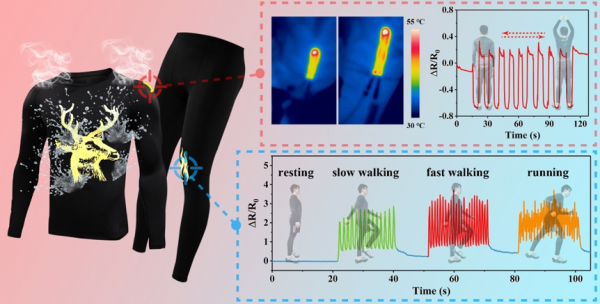At Case Western Reserve University, researchers have come up with an affordable means to change an ordinary shirt into an electronic smart shirt. This helps to track and adjust body temperature or even enable the wearer to apply heat to a back or sore shoulder.
 An example of the screen printed e-textiles developed by the researchers and diagrams from their paper in “Small.” Image Credit: Case Western Reserve University.
An example of the screen printed e-textiles developed by the researchers and diagrams from their paper in “Small.” Image Credit: Case Western Reserve University.
All developed from a design printed on the shirt’s fabric or any other piece of clothing.
The key to their innovation: A highly conductive ink and simple screen-printing process that leads to a waterproof, breathable and extremely flexible design that could function as a heating element while being powered by a coin-sized battery.
As per the market analysts, the wearable tech market, like the Apple Watch, FitBit and Bluetooth headset, is surging. However, a growing segment consists of electronic technology fixed in clothing, implanted in the body of the user, or even tattooed on the skin.
The Case Western Reserve-headed group of scientists believes its technique sticks out in the expanding wearable tech market for its ease, durability, comfort — and ultimately someday for its price.
They state their process, successful in laboratory testing, could someday be employed in mass production. The research group included collaborators from Wuhan, China. The research was published in the journal Small.
We believe this is a far better method than other attempts to make truly wearable technology because is not only has good performance initially, but is durable long term.
Changyong (Chase) Cao, Study Lead Author and Assistant Professor, Mechanical and Aerospace Engineering, Case Western Reserve University
Cao is an assistant professor at the Case School of Engineering. He is also the director of the Laboratory for Soft Machines and Electronics at Case Western Reserve. Cao stated that most available designs to integrate electronics into clothing have been with an elastomer or polymer surface. Frequently, those kinds of surfaces are uneasy and not breathable.
The Difference: A Conductive and Durable Ink
Cao stated that scientists have attempted two other methods to combine electronic fibers into the fabric: by spinning them into the material or by depositing conductive materials onto the cloth surface. The latter, like spray-coating and dip-coating, is more common since it is quicker and more economical.
Our new method improves on those by using the low-cost screen-print method to achieve a higher resolution level. That enables us to print the ink into more aesthetic patterns, or complex designs. The printed e-textiles are very stretchable and can keep working well even after multiple washings.
Changyong (Chase) Cao, Study Lead and Assistant Professor, Mechanical and Aerospace Engineering, Case Western Reserve University
According to the scientists, the vital factor was the usage of silver fractal dendrites — microscopic, branch-like filaments of silver. The filaments conduct electricity well — even if manipulated or distorted while in use.
The researchers added the microscopic solid metals to a water-based ink, thereby binding it to the molecules of the ink with a clear and highly elastic adhesive.
The ink, earlier covered with a thin layer of an invisible waterproofing agent that avoids the cracking of electrodes, can be printed or sprayed onto fabric.
Furthermore, the ink functions as a conductor of small amounts of electricity and could detect body motions and execute customized temperature management or control.
The scientists utilized a small coin battery, or button cell, like those found in car key fobs, thermometers or wristwatches to power the ink-based heating unit.
Journal Reference:
Tian, B., et al. (2022) Fully Printed Stretchable and Multifunctional E-Textiles for Aesthetic Wearable Electronic Systems. Small. doi.org/10.1002/smll.202107298.